 |
Focus features two in-depth reviews each month of fine art, architecture and design exhibitions and events at art museums, galleries and alternative spaces around Japan. The contributors are non-Japanese art critics living in Japan. |
|
|
 |
 |
 |
A First for Japan: Shunga at the Eisei-Bunko Museum
Michael Pronko |
 |
The Eisei-Bunko Museum is in a charming old residence on a side street in Mejiro, Tokyo. Photo courtesy of the Eisei-Bunko Museum. |
Japanese culture has long had an ambivalent relationship with erotic art, loving it secretly, but never exhibiting it openly. A current exhibition, titled Shunga (literally "spring pictures," a long-standing Japanese euphemism for erotic paintings), has overcome a number of restrictions to present a phenomenal display of hand-painted works and ukiyo-e woodblock prints from the Edo period (1603-1867).
Because all the works are erotic, and many of them explicitly so, finding a venue for the exhibition was not easy. The Eisei-Bunko Museum, a foundation and collection housed in a rambling multi-story residence in Tokyo's Mejiro district, finally agreed to host the show, but only after a roster of researchers, professors and art specialists went public with their views about the importance and value of these works. The 133 masterpieces in the exhibition were culled from the British Museum, various Japanese museums, and university and personal collections.
 |
|
Risqué Picture of the Tale of Genji (Abuna-e Genji Monogatari) by Eisei Keisen typifies the many scenes taken from famous stories, though subsequent works in the series would often veer towards satirized or imagined scenes. A scroll illustrating a similar pose instructs and encourages the couple. |
An exhibition in 2013 at the British Museum, Shunga: Sex and Pleasure in Japanese Art, helped pave the way for showing these works in the country of their origin. About half of the pieces at the Eisei-Bunko Museum were also in that 2013 show. Works by Kitagawa Utamaro, Utagawa Kuniyoshi, Hokusai Katsushika, and other ukiyo-e masters demonstrate that far from being an unusual or unknown genre, shunga were printed, painted and distributed widely, if somewhat covertly.
The Eisei-Bunko Museum, which also contributed pieces from its own collection, stored away the other national treasures, important cultural properties, and antique books it normally displays to make room for these erotic works. Seeing them in the homey comfort of the museum seems somehow appropriate, especially since the display cases allow for close viewing despite the crowds in attendance. The curators have also provided excellent information and commentary (mainly in Japanese) on the background, social reception, and history of shunga.
 |
|
Flower Calendar (Hana Goyomi) by Utagawa Kuniyoshi shows two lovers locked in passionate embrace. Shunga compositions were often connected to specific times of year. Bright colors and fluid lines played an important role in the emotional impact of most such works. Courtesy of the International Research Center for Japanese Studies. |
Although a few Japanese exhibitions included such erotic works in the past, this is the first time that a full-scale show consisting entirely of shunga has been held in Japan. The result is an eye-opening introduction to an engaging and unique genre of Japanese art. The exhibition includes roughly 100 erotic ukiyo-e woodblock prints, including "bean-size" prints about the size of your palm, along with 38 brush paintings by ukiyo-e masters.
And to answer the question on everyone's mind, yes, the works are highly explicit. Graphic depictions of sexual intercourse, in all its myriad forms, comprise the central focus. However, the pictures also convey stories with as much visual, mental and emotional contact as physical. The portrayals of the surroundings and circumstances of the sex acts open a window onto the cultural values and social practices of the day. Many of the images are also extremely funny: this is the only exhibition this reviewer has ever been to in Japan where visitors burst into open laughter.
 |
|
In a cropped version of Handscroll of Secret Love (Higi Zukan) by Nozawa Teiu, the facial expressions say it all. The brushwork on hand-painted pictures like this one is vivid, detailed and flowing. |
Laughing is appropriate, and in many ways, confirms the connection between Edo culture and contemporary attitudes. Shunga were as much entertainment, education, and stimulant as art. Collected works of various scenes were often given to newlyweds, friends, or customers in bordellos. However, the frankly sexual content can easily draw attention from the accomplished artistry of these works. The quality is stunning. One wonders whether the artists paid extra attention to their erotica -- or perhaps, because of the subject matter, they felt freer to innovate, with bolder lines, greater fluidity, and more distinctive compositions.
This cropped version of Handscroll for the Sleeve (Sode no Maki) by Torii Kiyonaga gives full play to the erotic nature of eye contact and hand gestures, all rendered with simple, fluid lines. Courtesy of the International Research Center for Japanese Studies. |
Many shunga are parodies of respected stories like Chushingura and The Tale of Genji, or of traditional scenes from classic poems and famous artworks. Even when not satiric, they suggest that sexuality is as much about setting, situation, and imagination as it is about physical urges.
The facial expressions of the subjects -- whether laughing, concentrating, surprised or entranced -- are especially captivating. Mouths open, eyebrows rise, hair loosens, and eyes close in ecstasy. Notably, the works do not portray the activity from the male point of view, unlike most commercial pornography, but present sexuality as a mutual interaction between equal and engaged participants, and as something gloriously deserving of artistic expression.
Twelve Erotic Scenes by Hishikawa Moronobu has two lovers, with the woman partially disrobed, flanked by suggestive imagery of a tiger and bamboo on the screen to the left, and soft cushions in distinctive shapes waiting in the rear. |
The value of this art is undeniable, making it hard to understand why it has taken so long to hold a special exhibit of these magnificent Japanese works inside Japan. It is a pleasure -- visually, artistically, historically, and culturally -- to see them brought together in so coherent an exhibition. Fortunately for residents of western Japan, a second show will be held in Kyoto from February to April 2016 at the Hosomi Museum.
All photos are courtesy of the Shunga exhibition or specific donors where noted.
|
 |
| | Shunga |
| | 19 September - 23 December 2015 |
| |
Eisei-Bunko Museum
1-1-1 Mejirodai, Bunkyo-ku, Tokyo
Phone: 03-5777-8600
Hours: 9:30 a.m. to 8 p.m. (to 6 p.m. Sundays); closed Mondays
Access: 15-minute walk from Edogawabashi Station on the Tokyo Metro Yurakucho Line, or 20-minute walk from Zoshigaya Station on the Tokyo Metro Fukutoshin Line |
|
 |
 |
Michael Pronko
Michael Pronko teaches American literature, film, art and music at Meiji Gakuin University. He has appeared on NHK, Sekai Ichiban Uketai Jugyo, and other TV programs. His publications include several textbooks and three collections of essays about Tokyo. He writes regular columns for Newsweek Japan, ST Shukan, The Japan Times, and for his own websites, Jazz in Japan and Essays on English in Japan. |
|
 |
|